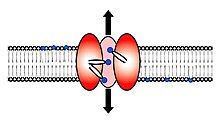Scramblases
Scramblase is a protein responsible for the translocation of phospholipids between the two monolayers of a lipid bilayer of a cell membrane. In humans, phospholipid scramblases (PLSCRs) constitute a family of five homologous proteins that are named as hPLSCR1–hPLSCR5. Scramblases are not members of the general family of transmembrane lipid transporters known as flippases. Scramblases are distinct from flippases and floppases. Scramblases, flippases, and floppases are three different types of enzymatic groups of phospholipid transportation enzymes. The inner-leaflet, facing the inside of the cell, contains negatively charged amino-phospholipids and phosphatidylethanolamine. The outer-leaflet, facing the outside environment, contains phosphatidylcholine and sphingomyelin. Scramblase is an enzyme, present in the cell membrane, that can transport (scramble) the negatively charged phospholipids from the inner-leaflet to the outer-leaflet, and vice versa.
Whereas hPLSCR1, -3, and -4 are expressed in a variety of tissues with few exceptions, expression of hPLSCR2 is restricted only to the testis. hPLSCR4 is not expressed in peripheral blood lymphocytes, whereas hPLSCR1 and -3 were not detected in the brain. However, the functional significance of this differential gene expression is not yet understood. While the gene and the mRNA of hPLSCR5 provide evidence of its existence, the protein has yet to be described in the literature.
Scramblase proteins contain a region of conservation that possesses a 12-stranded beta barrel surrounding a central alpha helix. This structure shows similarity to the Tubby protein.
The enzymatic activity of scramblase depends on the calcium concentration present inside the cell. The calcium concentration inside cells is, under normal conditions, very low; therefore, scramblase has a low activity under resting conditions. Phospholipid redistribution is triggered by increased cytosolic calcium and seems to be scramblase-dependent, resulting in a symmetric distribution of negatively charged phospholipids between both leaflets of the lipid bilayer. All scramblases contain an EF hand-like Ca2+binding domain that is probably responsible for the calcium activation of the enzyme. The activity of scramblase does not require energy, meaning that there is no contribution of adenosine triphosphate in the process.
...
Wikipedia

